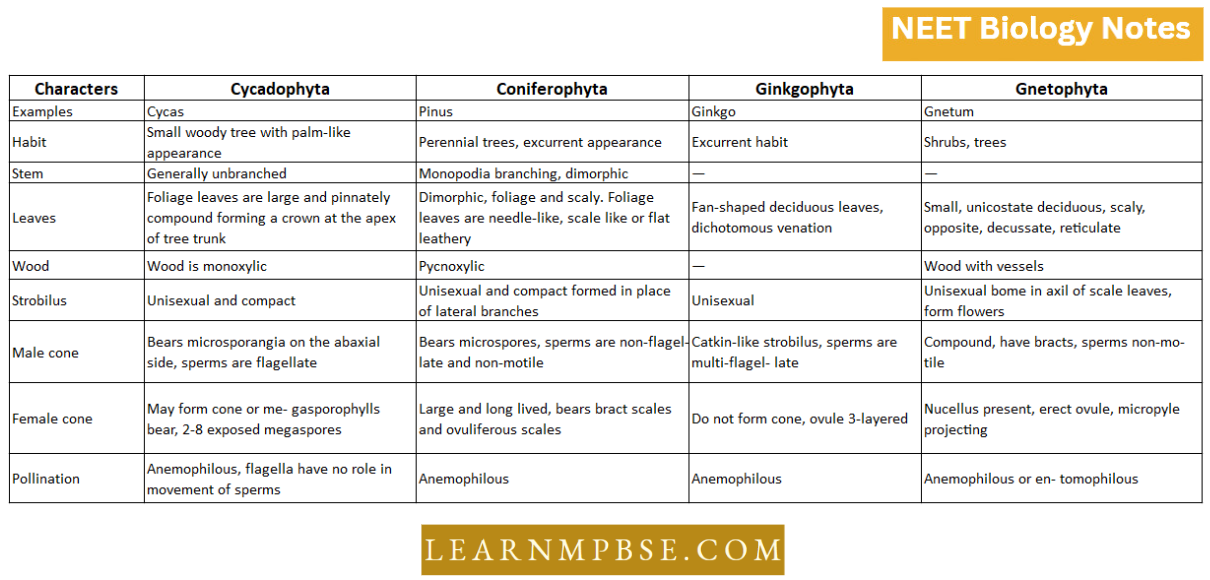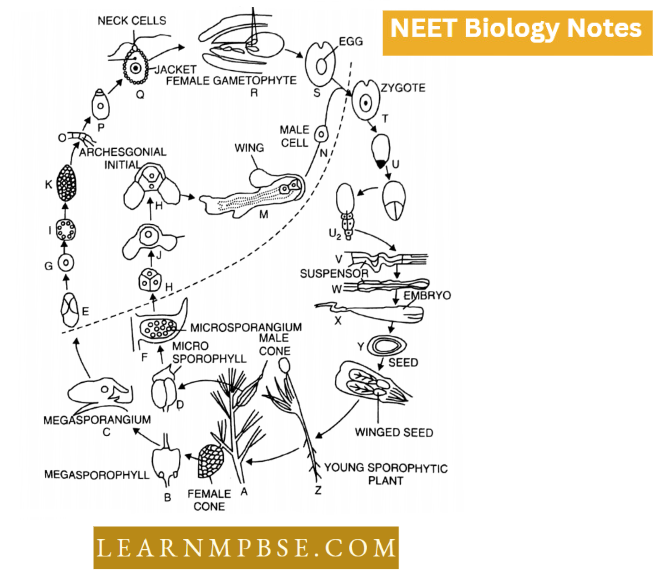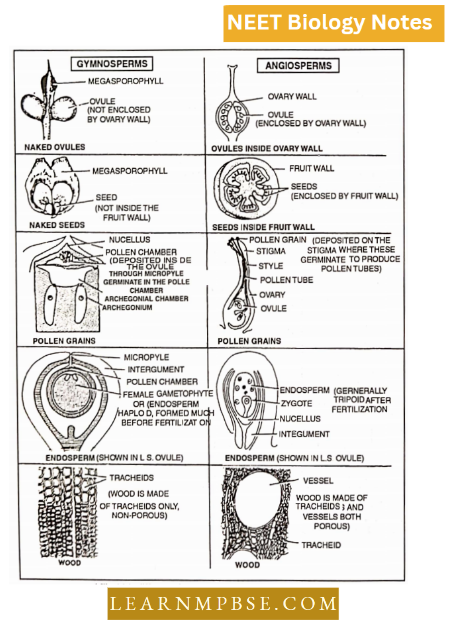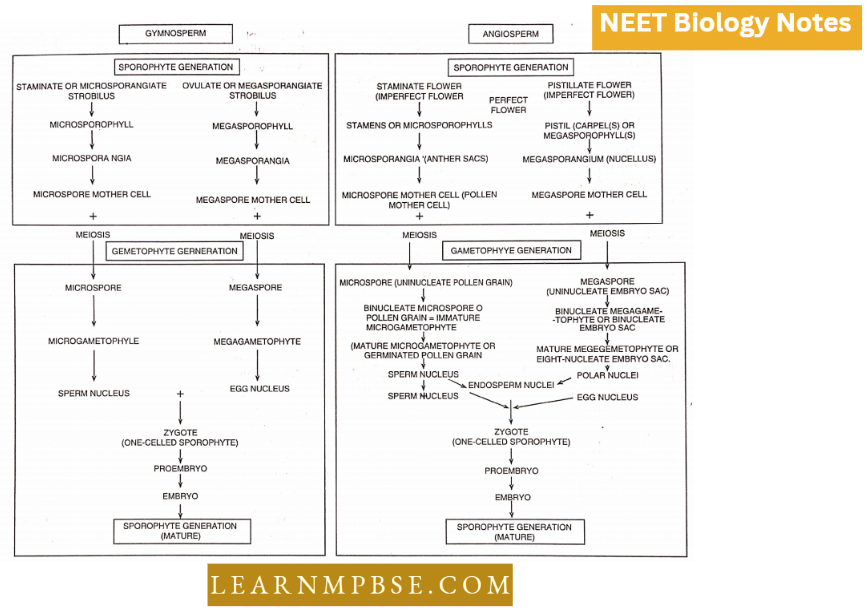NEET Biology Gymnosperms
- Gymnosperms are the ancestral seed-producing plants. The term ‘Gymno’ signifies nude, whereas ‘Sperma’ denotes a seed. The term gymnosperms refers to plants that possess naked seeds.
- Approximately 900 species of extant gymnosperms exist, with conifers comprising around 500 species of this category.
Features of Gymnosperms
- J. Gymnosperms are mainly woody plants represented by trees, shrubs etc. They are perennials.
- They bear tap roots. They may exhibit association with algae to form coralloid roots (Cyras) or with fungus to form mycorrhizal roots (Pinus).
- Leaves may be of one or two kinds i.e. foliage leaves and scale leaves. Leaves may be reduced (Ephedra), needle-like (Pinus) or large and pinnately compound (Cycas).
- The ovules arc orthotropus and covered by a single integument which is usually made up of outer fleshy, middle stony and inner fleshy layers.
- The main plant body is sporophyte which is heterosporous. The gametophytes are reduced. The female gametophyte is never shed. (t. The female gametophyte is constituted by haploid endosperm on which 2-8 archegonia are present. Neck canal cells are absent.
- Sexual reproduction is of the oogamous type.
- Male cones bear microsporophylls on which microsporangia are borne.
- Microspores (pollen grains) are formed in the microsporangia and they lead to the development of male gametophytes.
- The pollen tube grows through the female gametophyte and reaches near the archegonium.
- Syngamy occurs and oospore (2n) is fonned.
- All gymnosperms arc wind-pollinated. They are anemophilous.
- After fertilization, the oospore forms the embryo. Since they are formed by many oospores, each oospore forms the embryo. So there is the phenomenon of polyembryony.
- Ovules arc transformed into seed.
- Seeds contain two to many cotyledons which on germination give rise to diploid plants hence they arc polycotylcdonous.
Read and Learn More NEET Biology Notes
Gymnosperms NEET Notes
Classification of Gymnosperms


NEET Biology Gymnosperms Life Cycle Of Pinus
It is an exposed seed-bearing phanerogam. It is found in hills at different altitudes. The main plant body is a sporophyte. It is a large large-sized tree, with roots, stems and leaves.
Stem has long and dwarf shoots, the former shows unlimited growth and the latter shows limited growth. Leaves are scale and foliage (needle-like and green).
Dwarfbranches fall at regular intervals so the tree is evergreen. The plant attains a conical shape due to the excurrent mode of branching.
The stem shows a normal type of secondary growth. The wood is pyroxylin (hard and compact woods and monocyclic has only one ring of xylem. The bordered pits are uniseriate.
The plants are monoecious. The male and female reproductive organs are in the form of well-organized cones. The short male cones or strobila are seen clustered on the tip of the young shoot.
Several microsporophylls arc spirally arranged on an axis or thalamus. The male cone therefore is is aflower and not an inflorescence. On the lower surface of each microsporophyll are two or more microsporangia containing numerous microspore mother cells which divide meiotically to produce microspores or pollen.
At maturity, each microsporangium splits open by a longitudinal slit. Then pollen grains are released and dispersed by wind.
The female cone is a complex structure. The axis beats some spirally arranged bract scales in the axil each of which produces an ovuliferous scale. Each ovuliferous scale bears on its surface two ovules or megaspomngin.
The ovule consists of u muss covered by an integument growing from its base. It is differentiated into three lasers. The integument is often at the top forming a micropylc or oblique pore.
The two oxuliferxnis scales with the ovules are considered to form a separate shoot. The strobilus (connect is a compound one homologous with an inflorescence.
The cone takes about 2b months to reach maturity. Within the nucellus is present a single megaspore mother cell which divides by meiosis to form a linear tetrad of megaspores. The lowermost of the 4 megaspores remains functional. Gamclophvtcs.
Gymnosperms vs Angiosperms NEET
The pollen grains and die megaspores are the first cells of the male and female gametophyte respectively. At the time of pollination, pollen grains are shed at the 4-celled stage (2 prothallial cells, a generating cell and tube cell).
During pollination the whole atmosphere becomes yellow. People call it as Showers of Sulphur. The female gametophyte bears 1-5 (usually 3) archegonia. The archegonium consists of a venter and a short neck of 4 cells in two tiers.
The neck canal cell is absent. In the venter, there is a venter canal cell and a large oosphere characterised by a prominent nucleus and dense cytoplasm.
Fertilization is siphonogamous with the help of a pollen tube. The zygote or oospore produces an embryo.
Development is meroblastic. Sometimes more than one embryos are formed from the same zygote. This is called Cleavage polyembryony. Seeds are winged. Germination is epigeal. The seeds are polycotyledonous.
The three generations in the seed are:
- Testa, tegmen and perisperm represent parental sporophyte
- Endosperm represents female gametophyte
- Plumule, radicle, cotyledon represent future sporophyte.

NEET Biology Gymnosperms Some Facts Regarding The Life Cycle Of Cycas
- Cycas. Commonly called ‘sagopalm’ or ‘Cocopalm’ is a Gymnosperm of the order Cycadales and family Cycadaceae.
- Out of a total of 20 spaces. 6 species of Cycas are found in India (C. circinalis, C pcctinala. C. rumpliii, C. beddomei, C. revoluta and C. siamensis).
- Cycas appears like a palm and differentiates itself into roots, stems and leaves.
- Roots are of two types, i.e. normal tools which grow deep into the soil and coralloid roots which are coral-like, dichotomously branched, negatively geotropic and green in colour because of the presence of some blue-green algae(For example Nostoc, Anabaena, etc.).
- Stem is erect, stout and unbranched (rarely branched), and the leaves are of two types foliage leaves and scaly leaves.
- Foliage leaves are large, pinnately compound and reach up to 3 to 5 feet or more in length. Young leaflets are circinately coiled. 80-100 pairs of leaflets may be present in each leaf.
- Cycas is strictly dioecious = unisexual = Imperfect.
- Normal roots are generally radial diarchs.
- Coralloid roots are generally radial and exarch Triarch and always contain an algal zone in the cortex. The algal zone contains species of Anabaena, Nostoc, a few diatoms and some bacteria such as Azotobacter and Pseudomonas.
- Old stems contain 2-22 xylem rings showing polycystic condition. Mucilage canals are also present.
- In the rachis, the vascular bundles are arranged in an omega (Q)-shaped manner. The xylem is diploxylic i.e. consists of a centripetal xylem and a centrifugal xylem.
- Leaflets contain transfusion tissue, sunken stomata, and diplomatic xylem mesophyll differentiated into palisade and spongy parenchyma. Margins of the wings of the leaflet are straight in C. circinalis while revoluted in C. revoluta.
- Male cones and female megasporophylls or ovuliferous scales are present on different plants. The male cone reaches upto about 50 cm in height and contains several microsporophylls.
- On the abaxial (lower) surface of each microsporophyll are present thousands of microsporangia in groups of 3 to 5. Each group of microsporangia is called a sorus. Several pollen grains or microspores are found in each microsporangium.
- True female cones are absent. Female reproductive organs are present in the form of leaf-like megasporophylls.
- Each megasporophyll contains an upper dissected or pinnate leafy portion and a stalk. Ovules remain arranged in two rows on the stalk of the megasporophyll.
- Megasporophylls remain covered with many brown-coloured hairs.
- Cycas circinalis contains the largest ovule amongst the living gymnosperms of the world. It measures about 6 cm in length.
- Mature ovule is orthotropous and unitegmic. The single integument consists of 3 layers, i.e. outer fleshy layer, middle stony layer and inner fleshy layer.
- A hollow pollen chamber is present in the nucellar beak. In the female gametophyte are present two archegonia near the archegonial chamber.
- Pollination is directed by wind.
- The time between pollination and fertilization is 12-15 months.
- Dependence on water is overcome by siphonogamy.
- After fertilization, the ovule as a whole develops into a seed.
- Cycas show an alternation of generations.
Gymnosperms Examples For NEET
NEET Biology Gymnosperms Economic Importance Of Gymno Sperms
Gymnosperms are of great use in human welfare.
- Timber. Conifers provide a valuable limber Example Pinus roxburghii, Pinus longifolia (chir) Cedrus deodara {deodar), Pinus excelsa (kail)
- Protection from soil erosion. Gymnosperms commonly grow on slopes of hills where they hold the soil particles firmly against running water during the rains.
- Food. Seeds of Pinus ginardiana (chilgoza) are eaten after roasting. Roasted endosperm ofGinkgo, seed kernels of some Cycas species and Gnetum are edible. Sago grains can be obtained from the stem of Cycas. The latter is. therefore also called Sago Palm. Tender leaves of Cycas are cooked or added to curries.
- Abies balsamia yields a gum used as Canada balsam in microscopic studies.
- The resin obtained from the trunks of Finns roxburghii, P. wallichiana and P. insularis is used in the manufacture of turpentine oil and resin.
- Medicines. Drug ephedrine (obtained from stems of Eplicdra species) is given for asthma and bronchitis. Decoction of the stem is used to treat rheumatism. A gum from Cycast and C. circinalis is known to treat tumours. Taxol is an anticancer drug obtained from Tuuis.
- Sago. Cycas circinalis yields a starch Sago which is used as food.
- Sabudana is obtained from Cycas revoluta.
- Berries of juniper are used for flavouring alcoholic beverages like gin etc.
- Ornamental. Ginkgo (maidenhair tree), Tlnija, Pinus, Cycas, and Araucaria (monkey’s pu/./.lc) are grown for their ornamental value.
- Cedarwood oil is obtained from the heartwood of Juniperus Virginia.
- Young plants of P. merkusii (merkus pine) are used as raw material in the manufacture of craft paper.
- Wood of several gymnosperms is used in the preparation of pulp, e.g., Pinus, Abies, Picea, lurex, Tsuga, etc.
- Iannins. Bark of Tsuga canadensis (Hemlock) is used in tanning.
- linoleum. Saw dust formed during the preparation of timber is used in the formation of linoleum.
- Coverages and narcotics. Leaves of Tsuga canadensis are used in the preparation of tea. Wine is fermented from seeds and stems of Cvcas revoluta.


- Unitcgmic ovules are where the integument is differentiated into outer sarrotesta, middle sclerotesta and inner sarcotcsta.
- Chilgoza is the fruit of the gymnosperm and cannot be called true because the true fruit scientifically is a ripened ovary which is absent in the gymnosperm.
- Gymnosperms are naked-seeded plants.
- In Pinus. pollen grains are winged.
- Dwarf shoots arise in the axil of bracts on long shoots.
- The remnant nucellar tissue present within the seed covering of the embryo is called perisperin.
- Transversely oriented conducting parenchyma tissue of pine leaf is called transfusion tissue.
- Medicinally most important gymnosperms are Taxus and Ephedra.
- The only gymnosperm which lacks haploid endosperm is Gnetum.
- Pinus also exhibits cleavage polyembryony.
- The largest gametes of the biological kingdom belong to Cycas circinalis.
- Screw pine is the common name for Pandanus. Gnetum is an advanced gymnosperm. Ginkgo and Cycas arc the living fossils. Pimts is a conifer.
- The mature ovule of Cycas circinalis may reach upto 6 cm long and 4 cm in diameter and the Sperms arc is visible with the naked eye.
- Xylcm lacks vessels in gymnosperms (non-porous). Vessels have been reported in Gnetum, Ephedra and Welwitschia.
- In gymnosperm, endosperm is haploid and develops before fertilization.
- About two hundred million years ago, the gymnosperms formed the dominant vegetation on the earth.
- Ginkgo biloba is called a living fossil.
Gymnosperms Classification NEET
NEET Biology Gymnosperms Quanta To Memory
- Gnetum exhibits similarities with Angiosperms and is a sophisticated representative of the gymnosperms.
- The red wood of China is Pinus longifera.
- Conifers do not discard their foliage.
- Gymnosperm wood Manoxylic timber. Cambial activity is ephemeral; the cortex and pith are expansive; parenchymatous rays are wide; the wood is fragile and commercially unviable. Illustration: Cycas.
- Pycnoxylic timber. Cambial activity is prolonged; cortex and pith are diminished; parenchymatous rays are scarce; wood is dense and robust; wood is commercially significant and utilized as high-quality lumber. Illustration: Pinus.
- Gymnosperms are perennial plants.
- Gnetales possess vessels in the xylem, such as Ephedra and Gnetum.
- The resin duct is a schizogenous hollow generated by the separation of cells.
- In Gymnosperms, wood vessels are missing, consisting solely of tracheids.
- In gymnosperms, ovules are exposed and lack an ovary.
- Hydrostereone (Transfusion Tissue) Internal tissue in gymnosperm leaves comprises parenchymatous and tracheidial cells that function as lateral veins.
- In Cycas, the plants are dioecious, with male and female cones produced on separate individuals.
- In Bryophytes, Pteridophytes, and Gymnosperms, the female reproductive organs are termed archegonia, so referred to as archegoniate.
- In gymnosperms, the archegonium venter is not encased by sterile vegetative cells of the jacket.
- In gymnosperms, the nucellus secretes a pollen drop that facilitates the collection of pollen grains within the ovule’s pollen chamber.
- Pollen grains are haploid, and the endosperm of gymnosperms is also haploid; hence, their chromosomal numbers are identical.
- Ginkgo is a living fossil due to its flagellated male gametes. The Nucellus apex excretes sugar droplets to entice pollen, hence referred to as pollen drop.
- Essential oils obtained from gymnosperms include Cedar leaf oil from Thuja occidentalis. ‘Oil of Cade’: Juniperus oxycedrus Oil of Hemlock-spruce: Tsuga canadensis
- Cedarwood oil: Juniperus virginiana. Gymnosperms originated during the Upper Carboniferous epoch of the Paleozoic era, approximately 280 million years ago. Xylem exhibits diplomacy when it is centrifugal, as observed in the rachis of Cycas sp.
NEET Biology Gymnosperms Questions From Competitive Examinations
Question 1. Larges ovules, trees and gametes are found in:
- Monocots
- Dicots
- Both a and b
- Gymnosperms.
Answer: 4. Gymnosperms.
Question 2. The wood of Finns is:
- Manoxylic and homozygous
- Manoxylic and heterozygous
- Pycnoxylic and homozygous
- Pycnoxylic and heterozygous.
Answer: 3. Pycnoxylic and homozygous
Question 3. Male cone of pinus possesses
- Magasporophylls
- Microsporophylls
- Anthers
- Ligules.
Answer: 2. Microsporophylls
Question 4. Which one of the following has not changed for the last several thousand years?
- Dryopteris
- Gnetum
- Ginkgo
- Palms.
Answer: 3. Ginkgo
Question 5. The algal zone is characteristic of:
- Coralloid root of cycas
- The normal root of cycas
- The normal root of pinus
- Mycorrhizal root of pinus.
Answer: 1. Naked ovules
Gymnosperms NEET Mcqs
Question 6. Cycas have two cotyledons but not included in angiosperms because of:
- Naked ovules
- Seems like monocot
- Circinate praxis
- Compound leaves.
Answer: 1. Naked ovules
Question 7. Number of ovules present over megasporophyll of cycas is :
- 1—2
- 2—12
- 12—24
- 24—48.
Answer: 2. 2—12
Question 8. The endosperm of gymnosperms is:
- Haploid
- Diploid
- Triploid
- Tetraploid.
Answer: 1. Haploid
Question 9. A microsporophyll of pinus has :
- Two adaxial microsporangia
- Two abaxial microsporangia
- One abaxial microsporangium
- Four abaxial microsporangia.
Answer: 1. Two adaxial microsporangia
Question 10. Top-shaped multiciliale male gametes, and the mature seed which bears only one embryo with two cotyledons, are characteristic features of :
- Polypetalous angiosperms
- Gamopetalous angiosperms
- Conifers
- Cycads.
Answer: 2. Gamopetalous angiosperms
Question 11. The tallest tree is:
- Sequoia
- Eucalyptus
- Pinus
- Ranunculus.
Answer: 1. Sequoia
Question 12. Cycas is a gymnosperm because of :
- Naked sweet without fruit.
- Living fossils
- Vessels present in xylem
- None of the above.
Answer: 1. Naked seet without fruit.
Question 13. Select one of the following pairs of important features distinguishing gnetum from cycas and pinus and showing affinities with angiosperms:
- Perianth and two integuments
- Embryo development and apical meristem
- Absence of resin duct and leaf venation
- Presence of vessel elements and absence of archegonia.
Answer: 4. Presence of vessel elements and absence of archegonia.
Question 14. In which one of the following male and female gametophytes do not have free living independent existence?
- Polytrichum
- Cedrus
- Ptcris
- Funaria.
Answer: 2. Cedrus
Gymnosperms Lifecycle NEET
Question 15. The gametophyte is not an independent, free-living generation in:
- Polytrichum
- Adiantum
- Marchantia
- Pinus.
Answer: 4. Pinus.
Question 16. Cycas and adiantum resemble each other in having :
- Motile sperms
- Cambium
- Vessels
- Seeds.
Answer: 1. Motile sperms
